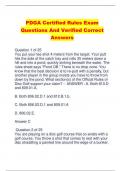Samenvatting
Summary Managing Innovation ALL LECTURES + GUESTLECTURE + LITERATURE
Content: - Lecture 1 Introduction - Lecture 2 + Chapter 1 What is innovation + Chapter 3 Innovation as a core business process - Lecture 3 + Chapter 2 Digital is Different + Chapter 4 Developing an innovation strategy - Lecture 4 + Chapter 5 Building the innovative organization - Lecture 5 ...
[Meer zien]














